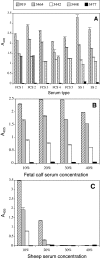Individual heterogeneity in erythrocyte susceptibility to Babesia divergens is a critical factor for the outcome of experimental spleen-intact sheep infections
- PMID: 19245784
- PMCID: PMC2695126
- DOI: 10.1051/vetres/2009008
Individual heterogeneity in erythrocyte susceptibility to Babesia divergens is a critical factor for the outcome of experimental spleen-intact sheep infections
Abstract
Susceptibility of sheep erythrocytes to Babesia divergens was investigated in vitro and a high inter-individual variability in their ability to support parasite population development was demonstrated, with some individuals having refractory red blood cells (RBC). As neither changes in growth conditions nor the use of different B. divergens strains influenced the level of susceptibility, the main factor postulated for this variability is the erythrocyte itself. Sheep therefore represent an excellent in vitro model to study the parasite-erythrocyte interaction. In addition, the existence of refractory RBC should help in the identification of the erythrocyte components required for B. divergens development. Experimental infections were carried out on spleen-intact sheep characterized by refractory or fully susceptible erythrocyte types. These differences translated into the successful infection of only those animals with susceptible erythrocytes: infected animals showed no clinical signs, but maintained an asymptomatic persistent infection, as usually observed in the natural bovine host. Sheep therefore represent model organisms that can allow us to study interactions between B. divergens and its vertebrate host at different levels of biological organisation, from the target cell to the intact animal, and represent an experimental infection model of concomitant immunity. Only a low percentage (13%) of the sheep population tested possessed susceptible erythrocytes and the potential role of sheep as a natural host or reservoir of B. divergens is discussed.
Figures




Similar articles
-
Sheep as a new experimental host for Babesia divergens.Vet Res. 2002 Jul-Aug;33(4):429-33. doi: 10.1051/vetres:2002029. Vet Res. 2002. PMID: 12199370
-
Babesia divergens experimental infection of spleen-intact sheep results in long-lasting parasitemia despite a strong humoral response: preliminary results.Vet Parasitol. 2009 Dec 23;166(3-4):205-11. doi: 10.1016/j.vetpar.2009.08.021. Epub 2009 Aug 29. Vet Parasitol. 2009. PMID: 19765903
-
In vitro host erythrocyte specificity and differential morphology of Babesia divergens and a zoonotic Babesia sp. from eastern cottontail rabbits (Sylvilagus floridanus).J Parasitol. 2006 Apr;92(2):333-40. doi: 10.1645/GE-662R.1. J Parasitol. 2006. PMID: 16729690
-
Unravelling the cellular and molecular pathogenesis of bovine babesiosis: is the sky the limit?Int J Parasitol. 2019 Feb;49(2):183-197. doi: 10.1016/j.ijpara.2018.11.002. Epub 2019 Jan 26. Int J Parasitol. 2019. PMID: 30690089 Free PMC article. Review.
-
Erythrocyte invasion by Babesia parasites: current advances in the elucidation of the molecular interactions between the protozoan ligands and host receptors in the invasion stage.Vet Parasitol. 2006 May 31;138(1-2):22-32. doi: 10.1016/j.vetpar.2006.01.037. Epub 2006 Feb 28. Vet Parasitol. 2006. PMID: 16504403 Review.
Cited by
-
The invasion process of bovine erythrocyte by Babesia divergens: knowledge from an in vitro assay.Vet Res. 2011 May 11;42(1):62. doi: 10.1186/1297-9716-42-62. Vet Res. 2011. PMID: 21569363 Free PMC article.
-
Anaemia in Sheep Caused by Babesia and Theileria Haemoparasites.Animals (Basel). 2022 Nov 29;12(23):3341. doi: 10.3390/ani12233341. Animals (Basel). 2022. PMID: 36496866 Free PMC article. Review.
-
Isolation and characterization of Babesia pecorum sp. nov. from farmed red deer (Cervus elaphus).Vet Res. 2014 Aug 26;45(1):78. doi: 10.1186/s13567-014-0078-7. Vet Res. 2014. PMID: 25155988 Free PMC article.
-
Stimulation and quantification of Babesia divergens gametocytogenesis.Parasit Vectors. 2016 Aug 8;9(1):439. doi: 10.1186/s13071-016-1731-y. Parasit Vectors. 2016. PMID: 27502772 Free PMC article.
-
Babesia spp. in ticks and wildlife in different habitat types of Slovakia.Parasit Vectors. 2016 May 20;9(1):292. doi: 10.1186/s13071-016-1560-z. Parasit Vectors. 2016. PMID: 27207099 Free PMC article.
References
-
- Bachmann A.W., Campbell R.S.F., Johnston L.A.Y., Yellowlees D.. Bovine haemoglobin types and their possible relationship to resistance to babesiosis: an experimental study. Tropenmed. Parasitol. 1977;28:361–366. - PubMed
-
- Bannister L., Mitchell G.. The ins, outs and roundabouts of malaria. Trends Parasitol. 2003;19:209–213. - PubMed
-
- Beale D., Lehmann H., Drury A., Tucker E.M.. Haemoglobins of sheep. Nature. 1966;209:1099–1102. - PubMed
-
- Brown W.C., Norimine J., Knowles D.P., Goff W.L.. Immune control of Babesia bovis infection. Vet. Parasitol. 2006;138:75–87. - PubMed
-
- Chauvin A., Valentin A., Malandrin L., L’Hostis M.. Sheep as a new experimental host for Babesia divergens. Vet. Res. 2002;33:429–433. - PubMed
Publication types
MeSH terms
LinkOut - more resources
Full Text Sources
Research Materials
